On a Tuesday evening in June 2018, a mate sent round the following message to our lads WhatsApp group: “Inflatable canoes, Lidl, central isle, £40, I’ve bought 2”. By Thursday we all had one, and predictably when a group of like-minded people are in receipt of a bunch of newly purchased river craft, a water based adventure must swiftly follow.
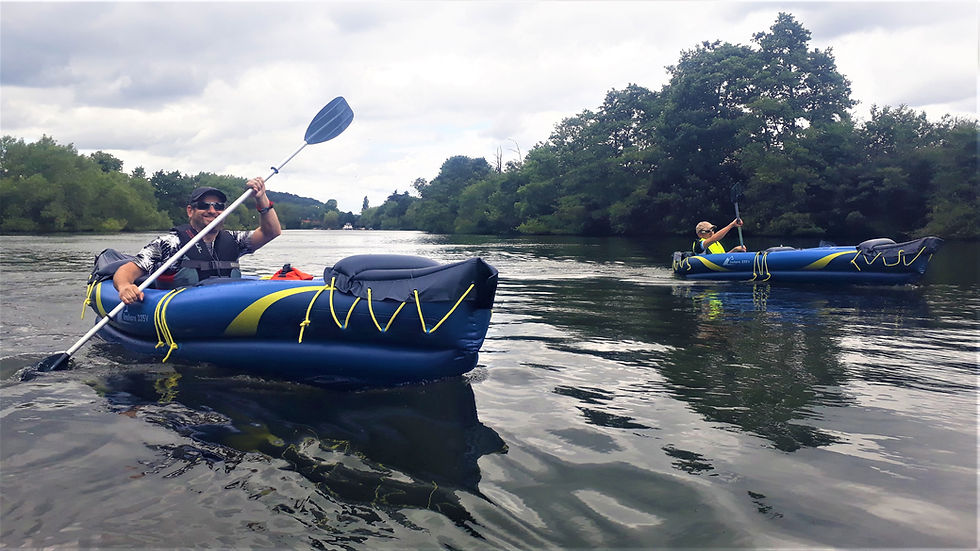
A river adventure had been on the cards for some time and a few months prior I’d bought a superb paddling guide called “Paddle the Thames” by Mark Rainsley. It therefore made perfect sense to pick a suitable section of this river, pack our kit and set off on a two day overnight paddle adventure.
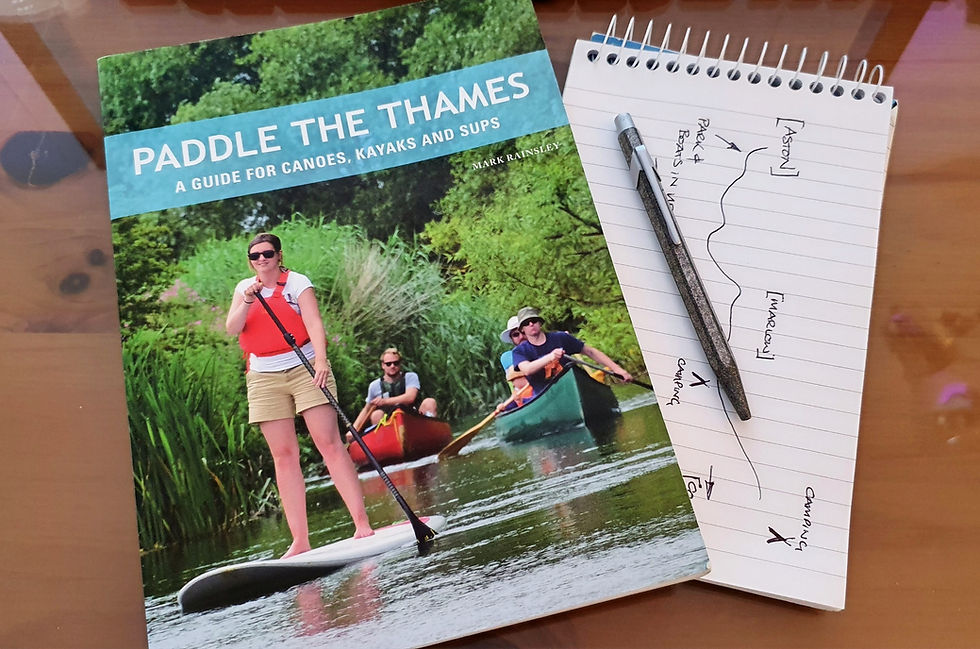
Day 1 - Ferry Lane, Aston to Ferry Lane, Cookham
As is invariably the case when four guys all with young families decide to go away together, there’s degree of understandable faff and compromise before we get going. But come 10am on Saturday morning we were busy at our Aston launch point dividing up essentials, inflating the canoes and ensuring anything we didn’t want to get wet was inside something waterproof. The launch was easy enough via the gentle slipway and an hour later we were heading downstream.


Navigation is a doddle on the river, you really can’t go that wrong, so it’s more a case of ticking off the landmarks as you go and keeping check on progress towards our destination. So it was fair to say that most of the morning was spent learning how the boats handled and what sort of cruising speed we could expect. The boats weren’t exactly rigid, it was more akin to paddling an enclosed lilo and the relatively low travelling speed was a result of their blunt and rather floppy design which was easily affected by the surface breeze or the wake of other passing river craft. But for a boat costing £40 and the fact they were facilitating a river adventure, we were absolutely chuffed to bits.

The river at Aston was perfect for our adventure; it’s about 40m wide with plenty of space for all river craft to pass and good towpaths if an emergency exit was required. We were aiming for the campsite at Cookham Lock some 15km away and at 3km per hour we were confident enough of an arrival around 5pm. We passed the tree covered and mysteriously named Magpie Island and spent probably a little too long recounting scenes from an Indiana Jones film as we explored some of its narrow backwaters.
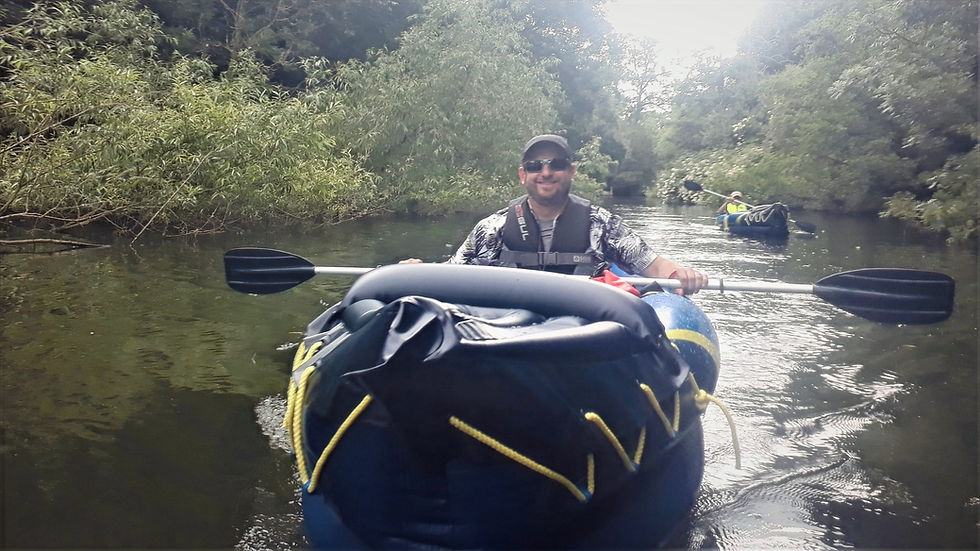
After detangling ourselves from the drooping willow trees we pressed on, rejoining the main channel and quickly arriving at the churning weir at Hurley Lock. Keeping well to the right we avoided its magnetic-like attraction and found a suitable point to alight for our first portage of the day.
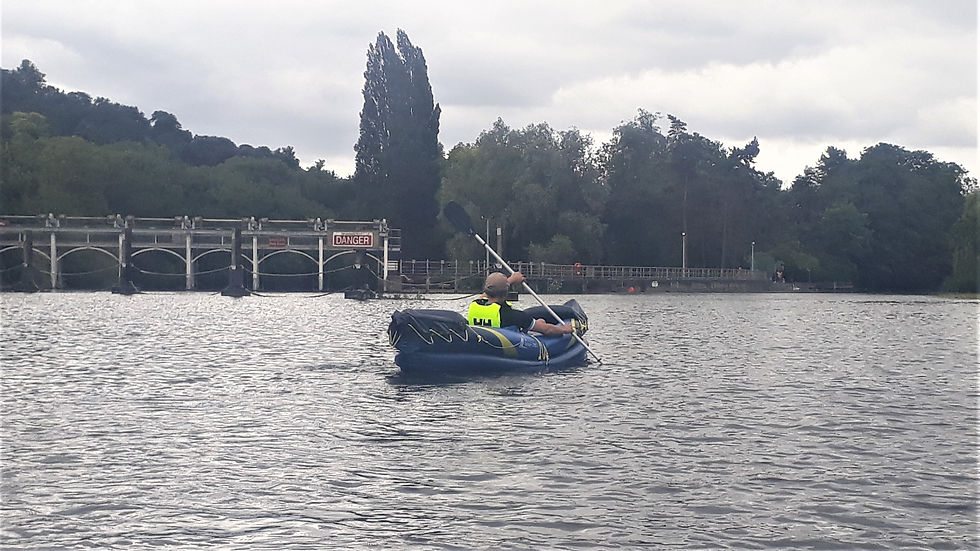


Hurley Lock was a great place to stop and stretch our legs, grab a slice of cake and at hot coffee at the café and, for some of us, to dry off. We’d decided to take three canoes between the four of us, myself and Marcus in one and Dan and Tim paddling solo. Inside our boat was relatively dry as Marcus and I were using half a paddle each – Canadian style - but the paddle drip stops didn’t work particularly well and when the paddle was used with a double blade - Kayak style - the water ran down the paddle into the cockpit meaning both Tim and Dan were soaked from the waist down.
A short paddle down the river brought us to Temple Lock with an alighting point to the left and fast flowing weir to the right. We carried the canoes around the locks once again and took full advantage of the public toilet facilities. I was pleasantly surprised with the Environment Agency run locks and facilities – ok they’re not the most salubrious - but they’re functional enough with toilets, hand basins and showers taking away the inconvenience of having to find decent facilities on route. The launch points are low enough for a kayak to easily enter and exit the river and the paths and steps are all well maintained.

There’s quite a sense on grandeur to the next section of the river. It’s lined with mature trees and equally mature old houses and the swans look perfectly at home gliding gracefully across the foreground. Arriving at Marlow we’d happened upon a school regatta. It was quite comical listening to the event marshals struggling to get a bunch of eager young lads to line up their rowing boats on the virtual start line. But seeing an opportunity to test our new river craft, we felt a race was in order. We hung back, well off to the side of the river, confident in our age and experience over the younger rowers, waiting for the starting gun to fire... I think we kept pace for all of about three meters before their boats sped past us to shouts of encouragement from competitive parents on the far bank.
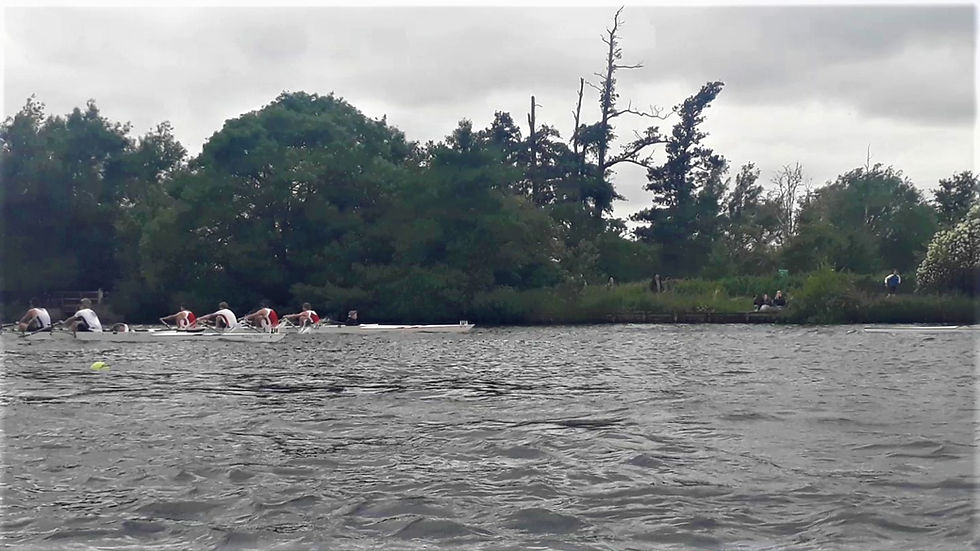
Marlow is a pretty town, even when viewed from the river, and its crescent shaped weir is equally as impressive. The nearby lock demanded another portage and, after a day of wet shorts and continually bailing out their boats, Tim and Dan decided to rejoin the water in a single canoe adopting the somewhat dryer paddling style myself and Marcus had enjoyed throughout the day.

The river opened out at this point, our boats feeling somewhat dwarfed by the expanse of flat water, but an hour after passing Gibraltar Island, we arrived at the slipway on Ferry Lane next to Cookham Lock pretty much on schedule. A well-deserved dinner at “The Ferry” pub topped of the trio of “Ferry” names for the day before heading down to the campsite on the island at Cookham Lock.
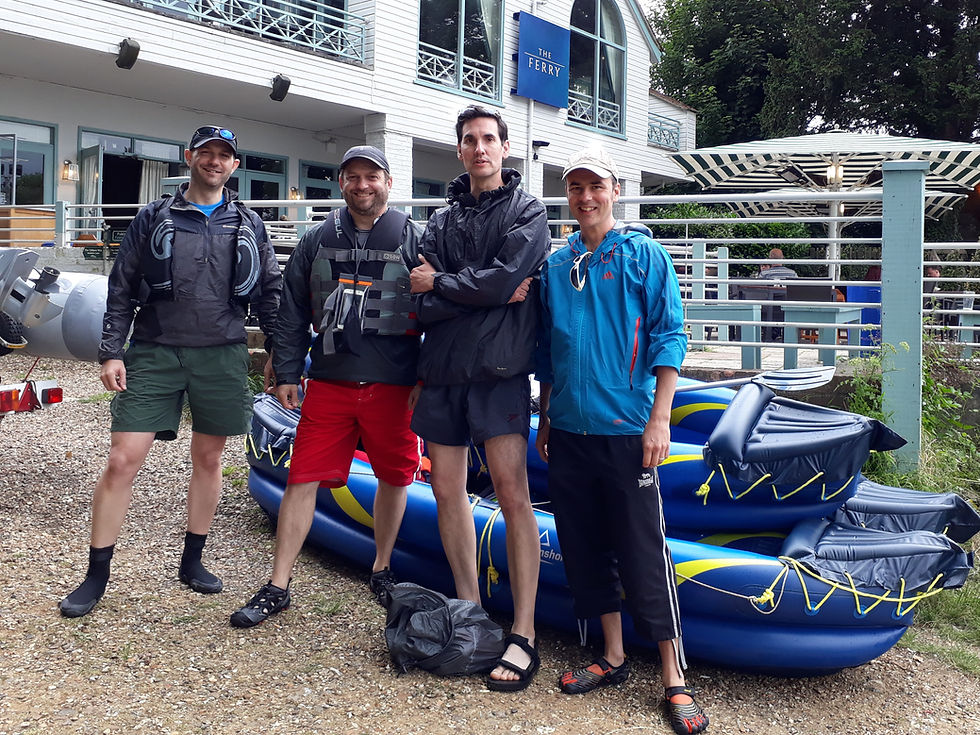
Day 2 – Cookham Lock to Windsor
None of us appeared to be hanging around this morning and as breakfast was planned for a later stop, we were back in the water by nine o’clock. Cookham Lock is a narrow shortcut across the main curve of the Thames with trees pressed hard up against the banks their boughs drooping low into the water. With a low layer of early morning river mist and just the sound of birds to accompany us, it felt like we were paddling down the Amazon. The National Trust's Cliveden House is just on the other side of the river and although the bankside trees block a direct view there are a number of pretty, mock Tudor buildings closer to the water.

Soon we were approaching Boulters Weir, an impressively large tier of steps with crashing water and ominous “Danger” signs protecting its entrance. Staying well to the right we avoided the natural pull of the water and docked at our alighting point. Although this is an island, much like many of the other locks, it is connected to the riverbank and can get quite touristy. Nothing wrong with that, in fact it provided us with good toilets, a great café and plenty of seating. It was a beautiful morning, the sun was already hot and our bacon baguettes and coffee purposefully took that much longer to consume.
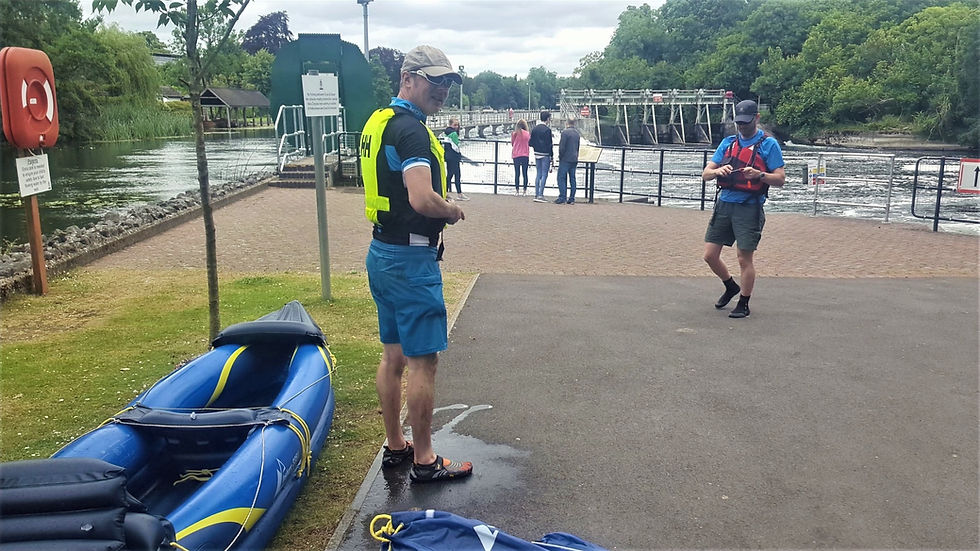
We found departing the island quite tricky for small river craft. The banks downstream of the weir are quite high and necessitated sitting on the bankside and lowering ourselves down into the boat from above. It’s quite tricky for a canoe or kayak but one with a floppy hull made it that much harder. Nevertheless, we all managed to get in our boats without an early morning swim and were back on our way.
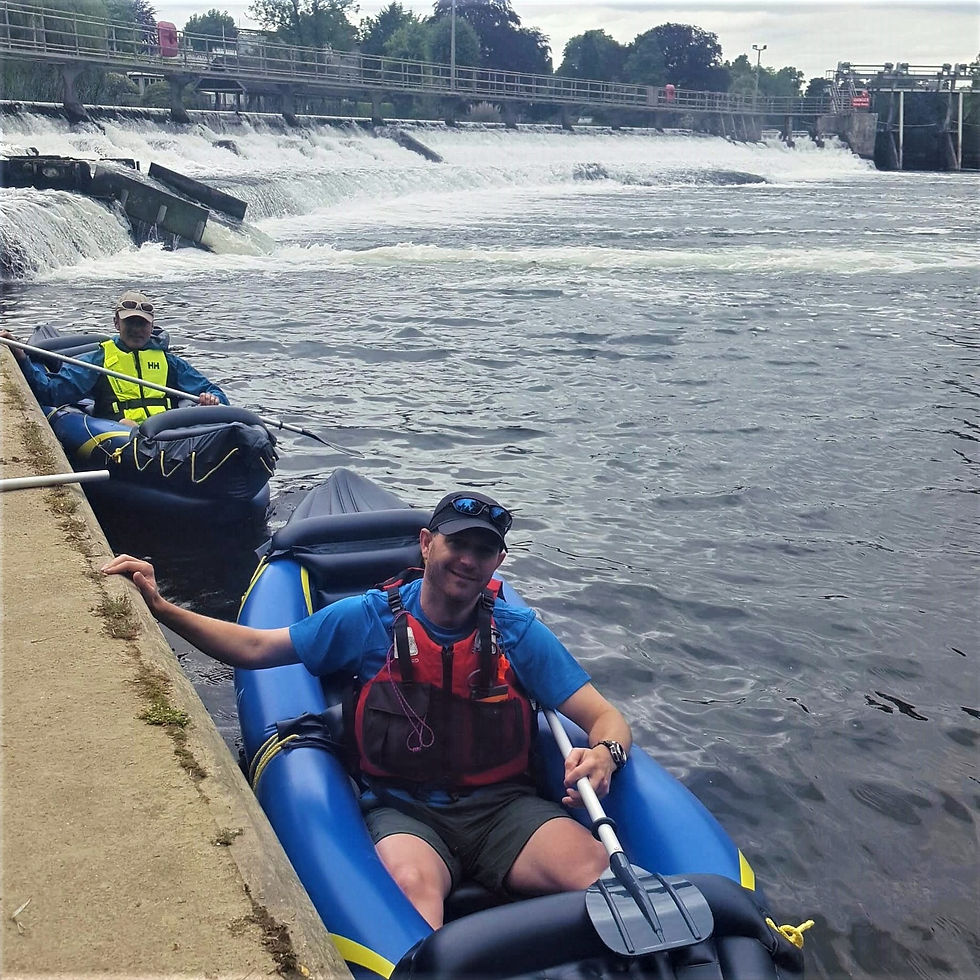
The river is much busier on this stretch, with gardens backing onto the river and plenty of boats lining the banks. A little further on, the main Ray Mead road runs parallel at this point bringing pedestrians and cyclists within conversational distance and a look more akin to a canal in Amsterdam. Shortly after this we were greeted by Brunel’s viaduct, built in 1838 for the Great Western Railway with it’s two, thirty nine meter long arches, which are apparently the longest in the world. Whilst the history was great, we found more fun in indulging our childlike antics finding out what sounds made the best echo! Just beyond was Bray, the location of some significantly expensive houses and a number of multiple Michelin Star pubs.
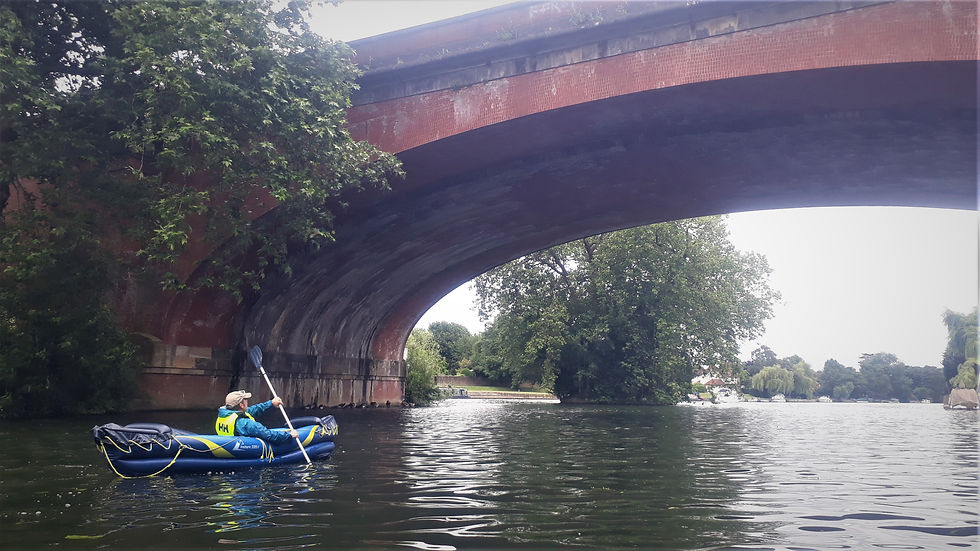
As you depart millionaires row, the river banks open out a little giving way to Bray studios on the right and, although you can’t see it, the almost runway like, Dorney Lake. The mornings hot sun had been rapidly fading throughout the last few hours and the head wind picking up. Speed was down to about 1.5kph at this point and with the first few drops of rain bouncing off our stretched polyurethane cocoons we decided to heed the words of the Lock Master at Bray Lock and call it a day. We dragged the boats out of the water a few kilometres short of Windsor and with a taxi ride to collect our cars we were packed up and heading home, weary, slightly damp but immensely smug at the success of our Lidl inflatable river adventure.
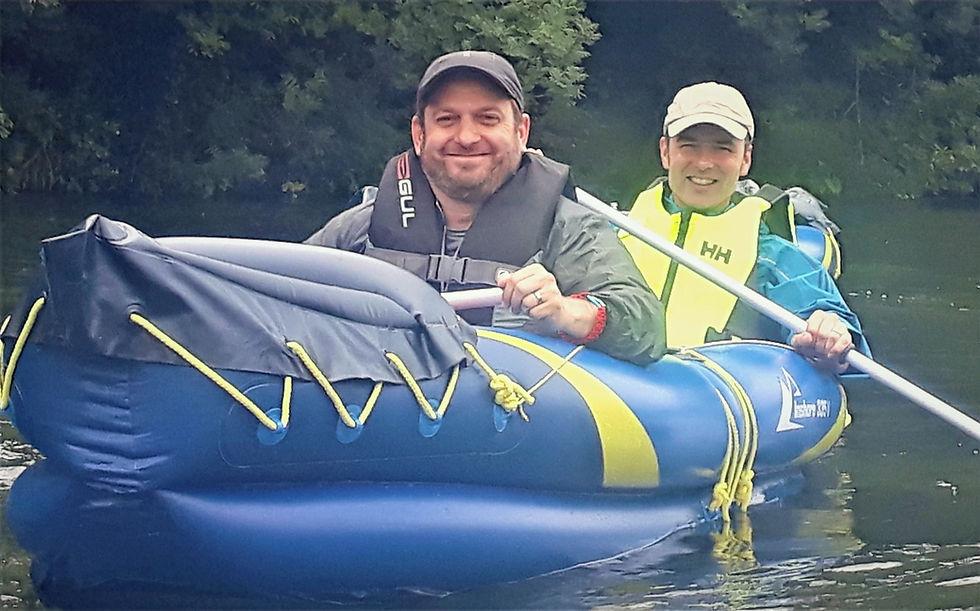
Tips for canoeing the River Thames
Route:
Total 18 miles (30km)
The route starts at Ferry Lane slipway, just north of the small village of Aston, Henley-on-Thames RG9.
Day 1 – Aston to Cookham - 9 miles (15km). Aston, Hurley Lock, Temple Lock, Marlow Lock, Gibraltar Islands, Bourne End Railway and Footbridge, Cookham Bridge, (Ferry Inn slipway), Cookham Lock.
Day 2 – Cookham to Windsor - 9 miles (15km). Cookham, Ray Mill Island / Boulters Lock, A4 (Bray) Bath Road Bridge, Guards Club Island, Maidenhead (Brunel / GWR) Railway Bridge, Bray Lock, M4 Motorway bridge, Monkey Island, Summerleaze Footbridge, Boveney Lock, A332 Road bridge, Windsor Leisure Centre.

The attachments below are .gpx files of the entire route for Day 1 and Day 2. Please feel free to download and modify to suit your own adventure accordingly.
Accommodation:
Cookham Lock campsite, Odney Lane, Cookham, SL6 9SRH https://www.visitthames.co.uk/about-the-river/river-thames-locks/cookham-lock
Eating and Drinking:
Hurley Lock Tea Shop, 112A Mill Ln, Hurley, Maidenhead SL6 5ND.
The Ferry pub, Sutton Road, Maidenhead, Berkshire, SL6 9SN. 01628 525123. https://www.theferry.co.uk/
Ray Mill Island café, Boulters Lock, Ray Mead Rd, Maidenhead SL6 8PE
Equipment:
We had three Inshore 335 mk 5 inflatable canoes purchased from Lidl which come with one, split double paddle. You could equally use a canoe, kayak, paddle board, raft or rubber ring.
30 ltr, fully waterproof, roll top dry bag + 5 ltr dry bag to carry equipment needed in the cockpit.
Sleeping: Tarp, Bug bivi, sleeping bag, inflatable mattress and pillow
Paddling clothes: Buoyancy aid, wetsuit boots, swimming shorts, t-shirt, windproof smock, waterproof jacket, cap, glasses.
Spare clothes: Complete change of clothes including down jacket and trainers.
Wash kit and first aid items (including sun cream)
Head torch, multitool
Ordnance Survey 1:25,000 map in map case
Mobile phone, GPS, battery, cables
Snacks, 1 ltr water bottle
Collapsible seat and sit mat
Canoe maintenance kit: Pump, sponge, gaffa tape, puncture repair kit, rope, throw line and a selection of karabiners for securing equipment on board. Most of this was in another dry bag and carried as group kit between the four of us.
Notes:
The Thames section we were paddling on is managed by The Environment Agency. Some useful information can be found here: https://www.gov.uk/guidance/river-thames-locks-and-facilities-for-boaters#camping-at-lock-sites
We only took snacks and a 1 ltr water bottle each as there were plenty of places to eat and drink on route. Stopping is necessary for portages and also made for convenient occasions to stretch our legs and use the public toilets.
You'll need a license to paddle on many of the UK’s rivers, including the Thames. We all joined British Canoeing which, for the single membership fee, granted us a license to paddle across the whole of the UK for a year. If you've never paddled down a river before then its also worth familiarising yourself with some do's and don'ts of river travel and some appropriate river etiquette in order to stay the right side of other (bigger!) boats. https://www.britishcanoeing.org.uk

Comments